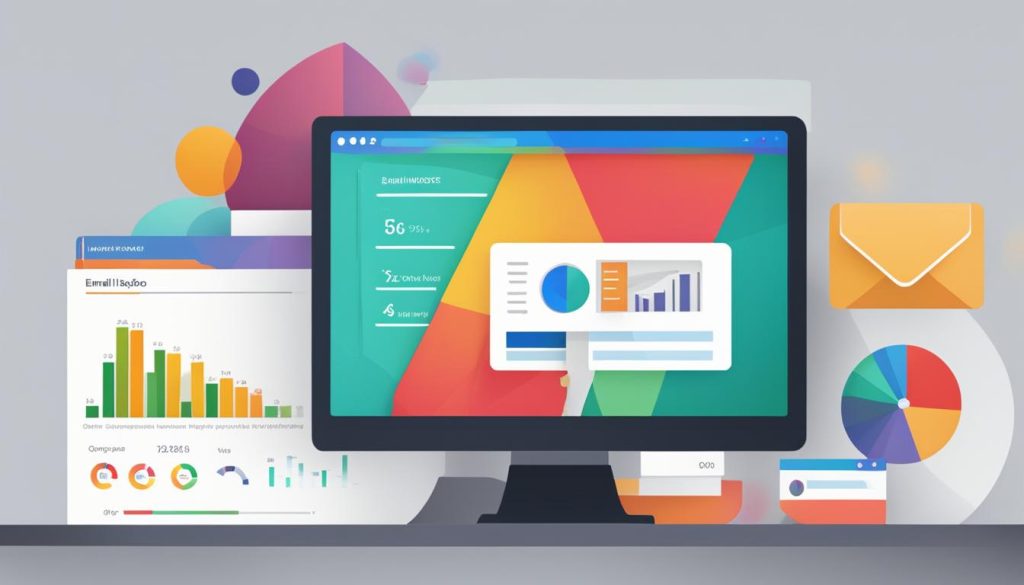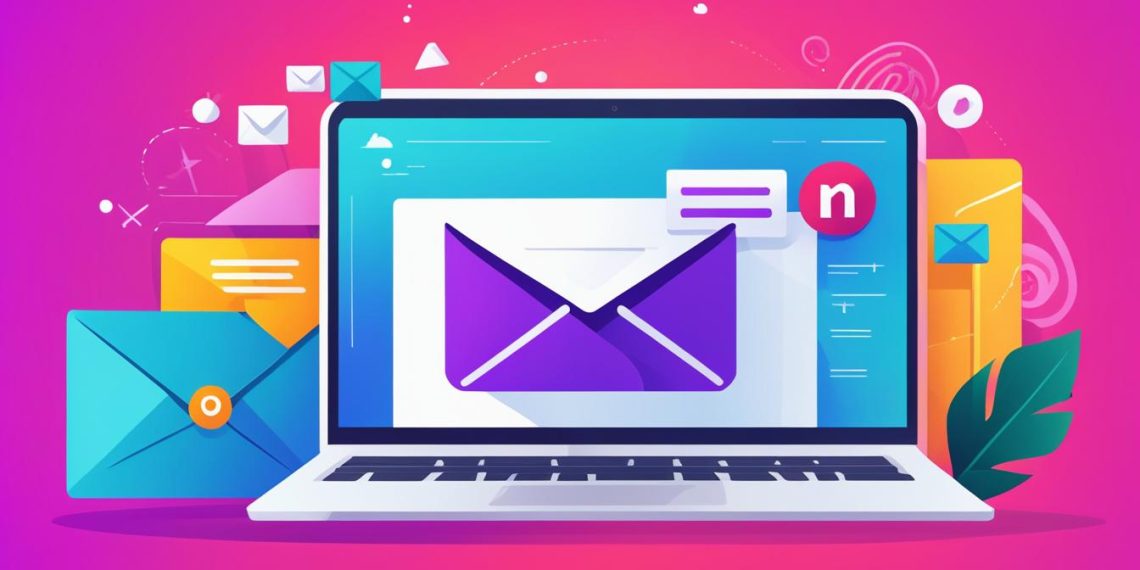Segmenting your email list based on subscribers’ interests, activities, or demographic characteristics is an intelligent strategy that can greatly enhance your affiliate marketing efforts. By organizing your email recipients according to what they prefer, do, or who they are, you can provide them with content that genuinely matches their desires. This technique is expected to increase your email open rates, boost click-through rates, raise the level of engagement with your promotions, and consequently, amplify your earnings. Essentially, if you’re targeting success in affiliate marketing, consider this approach as your essential strategy for success.
Key Takeaways:
- Email list segmentation allows you to divide your recipients into targeted groups for more personalized marketing.
- Segmentation leads to increased open rates, higher click-through rates, and improved conversion rates.
- It helps decrease unsubscribe rates and ensures compliance with regulations.
- Email service providers and tools like OptinMonster can assist in implementing effective segmentation strategies.
- By segmenting your email list, you can maximize the efficiency and effectiveness of your affiliate marketing campaigns.
What is Email Segmentation?
Email segmentation, also known as list segmentation, is the practice of dividing your email list into smaller, targeted groups based on specific criteria. By segmenting your list, you can send more personalized and relevant emails to each group, increasing engagement and conversions.
There are various criteria you can use to segment your email list, such as behavioral and demographic data. For example, you can segment based on past purchases, location, website interactions, or any other data points that are relevant to your audience.
By sending targeted emails to each segment, you can tailor your content to their specific needs and interests. This approach not only improves the overall customer experience but also boosts open rates, click-through rates, and conversions.
Email segmentation allows you to break down your email list into smaller, more manageable chunks, enabling you to deliver highly targeted messages that resonate with your audience. By customizing your emails based on specific criteria, you can make a stronger connection and drive better results.
For example, let’s say you are an online clothing retailer. You can segment your email list based on the past purchase history of your subscribers. By sending targeted emails with personalized product recommendations or exclusive discounts based on their previous purchases, you can increase the chances of repeat purchases and customer loyalty.
Benefits of Email Segmentation:
- Improved engagement and open rates
- Higher click-through rates
- Increased conversions and ROI
- Reduced unsubscribe rates
- Enhanced customer satisfaction and loyalty
| Email Segmentation Benefits | Description |
|---|---|
| Improved engagement and open rates | Sending personalized emails to targeted segments captures the attention of recipients and encourages them to open and read your emails. |
| Higher click-through rates | Relevant and tailored content increases the likelihood of recipients clicking on links within your emails and taking desired actions. |
| Increased conversions and ROI | By delivering highly targeted content and offers, you can drive more conversions and generate a higher return on your email marketing investment. |
| Reduced unsubscribe rates | When you send emails that are relevant to your subscribers’ interests, they are less likely to unsubscribe from your list. |
| Enhanced customer satisfaction and loyalty | By personalizing your emails and catering to the specific needs and preferences of your audience, you can build stronger relationships and foster customer loyalty. |
Email segmentation is a powerful strategy to unlock the full potential of your email marketing efforts. It allows you to deliver targeted emails that resonate with your audience, resulting in higher engagement, conversions, and customer satisfaction.
Benefits of Email Segmentation
Email segmentation offers several benefits, creating a highly targeted approach to your email marketing. By dividing your email list into specific segments, you can deliver personalized content that resonates with your audience’s interests, needs, and preferences. This results in the following advantages:
- Increase open rates: By sending tailored emails to each segment, you can grab the attention of your subscribers and encourage them to open your messages.
- Higher click-through rates: Relevant content prompts recipients to take action, resulting in increased click-through rates and engagement.
- Improved conversion rates: When you deliver personalized offers or recommendations, it increases the likelihood of converting recipients into customers.
- Decreased unsubscribe rates: By delivering content that matches the specific needs of your subscribers, you can reduce the likelihood of them opting out of your mailing list.
- Enhanced customer retention: Personalized and relevant emails show your subscribers that you understand their preferences and value their business, increasing their loyalty and likelihood of staying engaged.
- Efficient use of resources: By targeting specific segments with tailored content, you can optimize your resources by focusing on the recipients who are most likely to respond positively.
- Better data and insights: Segmenting your email list allows you to gather valuable data on each group, providing insights into their behavior, preferences, and purchasing patterns.
- Compliance with regulations: Email segmentation enables you to ensure compliance with regulations, such as the General Data Protection Regulation (GDPR), by delivering content that is explicitly requested or relevant to each subscriber.
- Increased sales: Through personalized and targeted emails, you can nurture relationships with your subscribers, leading to increased sales and revenue for your business.
These benefits highlight the power of email segmentation in driving the success of your email marketing campaigns. It allows you to deliver the right message to the right people at the right time, resulting in improved engagement, conversion rates, customer satisfaction, and overall business growth.
How to Segment Your Email List
Segmenting your email list is a crucial step in maximizing the effectiveness of your email marketing campaigns. By dividing your subscribers into smaller, targeted segments, you can ensure that your emails are relevant and engaging to each recipient. Here are some key methods for segmenting your email list:
Demographic Segmentation
Demographic segmentation involves dividing your subscribers based on personal characteristics such as age, gender, income, or occupation. This allows you to tailor your email content to specific demographics and create a more personalized experience.
Geographic Segmentation
Geographic segmentation focuses on dividing your subscribers based on their location. This can be as broad as country or region, or as specific as zip code or city. Geographic segmentation helps you deliver location-specific offers or promotions and target subscribers with relevant information or events in their area.
Behavioral Segmentation
Behavioral segmentation categorizes your subscribers based on their interactions with your emails, website, or previous purchases. By analyzing their behavior, you can send targeted emails that align with their interests and preferences. Examples include segmenting based on email engagement level, purchase history, or sales funnel position.
Email Engagement Level
Segmenting based on email engagement level enables you to categorize subscribers based on their interaction with your emails. This can include open rates, click-through rates, or response to specific calls to action. By segmenting based on engagement, you can send more targeted content and re-engage subscribers who may be losing interest.
Abandoned Cart
Segmenting subscribers who have abandoned their shopping carts can help you recover potentially lost sales. By sending targeted emails with reminders or incentives, you can encourage them to complete their purchase and increase your conversion rate.
Email Preferences
Email preference segmentation allows subscribers to choose the types of content they want to receive. By respecting their preferences and sending them relevant content, you can ensure higher engagement and reduce the risk of unsubscribes.
Membership or Subscription Type
If your business offers different membership tiers or subscription options, segmenting based on membership or subscription type allows you to deliver tailored content or promotions to each group.
Seasonal Purchasing Behavior
Segmenting based on seasonal purchasing behavior allows you to target subscribers who have shown specific buying patterns during different times of the year. This helps you provide them with relevant offers or promotions during those seasons.
Event Attendance
If you organize events or webinars, segmenting based on event attendance allows you to target subscribers who have shown interest in attending similar events in the past. This enables you to send them information about upcoming events or exclusive offers.
Technology Usage
Segmenting based on technology usage helps you categorize subscribers who use specific devices, software, or apps. This allows you to tailor your emails to their preferred technology and optimize the user experience.
By implementing these segmentation strategies, you can create more personalized and relevant email campaigns that resonate with your subscribers. Remember, effective segmentation requires collecting and analyzing relevant data, so make sure to use a reliable email marketing platform that provides robust segmentation capabilities.
Methods for Email List Segmentation
| Segmentation Method | Description |
|---|---|
| Demographic Segmentation | Dividing subscribers based on personal characteristics like age, gender, and income. |
| Geographic Segmentation | Dividing subscribers based on their location, such as country, region, or city. |
| Behavioral Segmentation | Segmenting based on interactions with emails, website, or previous purchases. |
| Email Engagement Level | Segmenting based on subscribers’ interaction with your emails. |
| Abandoned Cart | Segmenting subscribers who have abandoned their shopping carts. |
| Email Preferences | Allowing subscribers to choose the types of content they want to receive. |
| Membership or Subscription Type | Segmenting based on different membership or subscription options. |
| Seasonal Purchasing Behavior | Segmenting based on buying patterns during different seasons. |
| Event Attendance | Segmenting based on past event attendance or interest. |
| Technology Usage | Segmenting based on subscribers’ preferred devices, software, or apps. |
Email Segmentation Tools and Software
To effectively segment your email list and optimize your email marketing efforts, you need a reliable email service provider that offers robust list segmentation capabilities. Here are some popular email service providers:
- Constant Contact
- Drip
- AWeber
- ConvertKit
- ActiveCampaign
These providers allow you to categorize your subscribers based on their interests, behaviors, or demographics, enabling you to send targeted and personalized emails to specific segments.
Additionally, an effective tool you can use alongside your email service provider is OptinMonster. OptinMonster helps you create visually appealing and high-converting email opt-in forms. You can easily integrate OptinMonster with your email service provider to seamlessly capture leads and automatically segment them into relevant lists.

The image above represents the OptinMonster logo, showcasing the power of this tool in capturing and segmenting email leads. With the integration of an email service provider and OptinMonster, you can enhance your email segmentation strategy and drive better engagement and conversions.
Email Segmentation Strategies
When it comes to maximizing the effectiveness of your email marketing campaigns, implementing the right email segmentation strategies is crucial. By targeting specific segments of your audience with personalized content, you can significantly improve engagement, conversions, and customer loyalty. Here are some effective email segmentation strategies to consider:
- Onboarding Emails for New Subscribers: Welcome new subscribers with a series of onboarding emails to introduce your brand, products/services, and provide valuable resources or exclusive offers.
- Demographic Segmentation: Divide your email list based on demographic information such as age, gender, location, or industry to deliver targeted messages that resonate with different audience groups.
- Behavioral Segmentation: Analyze and segment your audience based on their past interactions and behaviors, such as website visits, clicks, or purchases. Tailor your emails to target specific actions or interactions.
- Purchase History: Segment your audience based on their purchase history to send relevant offers, recommendations, or product updates that align with their past buying preferences and behaviors.
- Personal Preferences and Survey Responses: Leverage the personal preferences and survey responses of your subscribers to create tailored email content that matches their interests, needs, and preferences.
- Engagement Level: Segment your audience based on their engagement level with your emails. Send targeted messages to highly engaged subscribers to nurture their relationship with your brand or re-engage inactive subscribers.
- Seasonal Promotions and Upcoming Events: Use seasonal promotions, holidays, or upcoming events to target specific segments. Customize your emails to offer promotions or content related to the specific occasion or event.
- Remarketing and Cross-selling: Segment your audience and retarget those who have shown interest or abandoned their cart. Create personalized emails with recommendations, discounts, or related products/services to encourage conversions.
- Customer Retention: Implement personalized email campaigns to nurture customer relationships, show appreciation, and provide exclusive offers to loyal customers. Keep them engaged and increase their lifetime value.
- Re-engagement Campaigns: Target inactive subscribers with re-engagement emails to win them back. Provide incentives, ask for feedback, or offer personalized recommendations to reignite their interest.
- VIP or Loyalty Programs: Create exclusive segments for your most loyal customers or VIP members. Offer special perks, rewards, or early access to new products/services to strengthen their loyalty and advocacy.
- Abandoned Cart Follow-ups: Segment those who have abandoned their carts and send targeted emails reminding them about their pending purchase, offering incentives, and addressing any barriers to completion.
Implementing these email segmentation strategies will enable you to deliver highly targeted and personalized emails that resonate with your subscribers. By catering to their individual needs, preferences, and behaviors, you can build stronger connections, drive conversions, and achieve better results from your email marketing efforts.
Segmenting for Increased Conversion Rates
Segmenting your email list is a critical strategy for maximizing conversion rates. By implementing personalization, A/B testing, targeted offers, and delivering relevant content, you can significantly improve the effectiveness of your email marketing campaigns.
Personalization plays a key role in engaging your subscribers. By tailoring your email content to each segment’s specific interests, preferences, and behaviors, you create a more personalized experience that resonates with your audience. This level of personalization increases the chances of your subscribers taking action, leading to a higher conversion rate.
A/B testing allows you to optimize your email marketing strategies. By testing different variations of subject lines, call-to-actions, layouts, or even entire campaigns, you can identify the most effective approach for each segment. Through continuous testing and refinement, you can improve your conversion rates over time.
“Implementing targeted offers is a powerful way to increase conversion rates. By analyzing the characteristics and behaviors of each segment, you can create irresistible offers that address their specific needs, pain points, and desires. Targeted offers create a sense of exclusivity and relevance, motivating your subscribers to take action.”
Delivering relevant content is essential for engaging your subscribers and driving conversions. By understanding the needs and interests of each segment, you can provide them with valuable information, product recommendations, or exclusive promotions that are highly relevant to their situation. This relevancy builds trust and encourages action, ultimately boosting your conversion rates.
Take a look at the table below to understand how personalization, A/B testing, targeted offers, and relevant content contribute to increased conversion rates:
| Segmentation Strategy | How It Helps Increase Conversion Rates |
|---|---|
| Personalization | Creates a tailored experience that resonates with subscribers, encouraging them to take action. |
| A/B Testing | Optimizes email marketing strategies based on data-backed insights, leading to higher conversion rates. |
| Targeted Offers | Addresses the unique needs and desires of each segment, motivating them to convert. |
| Relevant Content | Provides valuable information, recommendations, and promotions that align with each segment’s interests and needs, increasing conversion rates. |
By implementing personalization, conducting A/B testing, offering targeted promotions, and delivering relevant content, you can significantly enhance your email marketing strategy and achieve higher conversion rates. Remember, the key is to understand your audience and tailor your approach to meet their specific needs and preferences.

Automation and Email Segmentation
Email segmentation is made even more effective with the use of automation. By setting up automated campaigns, triggered emails, email workflows, and personalized sequences, you can streamline your email marketing efforts and ensure that the right messages are sent to the right segments at the right time.
Automated campaigns allow you to create a series of emails that are sent automatically based on predefined triggers or actions. These campaigns can be set up to target specific segments of your email list, ensuring that each recipient receives personalized and relevant content.
Triggered emails are sent in response to specific actions or events, such as a customer making a purchase or signing up for a newsletter. These emails are highly targeted and can be used to deliver relevant offers, recommendations, or follow-up messages.
Email workflows are a series of automated actions that are triggered by specific events or conditions. They can be used to guide subscribers through a predefined sequence of emails, delivering timely and relevant content based on their interactions or behaviors.
Personalized sequences take automation a step further by tailoring the content and timing of emails based on individual subscriber preferences and behaviors. By tracking and analyzing data, you can create personalized journeys for each segment of your audience, delivering a highly customized experience that drives engagement and conversions.
Automation and email segmentation work hand in hand to maximize the effectiveness of your email marketing efforts. By leveraging automated campaigns, triggered emails, email workflows, and personalized sequences, you can create a seamless and targeted communication strategy that delivers the right message to the right person at the right time.
Email Automation Platforms and Tools
To implement automation and email segmentation, you’ll need the right tools. Here are some popular platforms and tools that can help:
| Email Service Provider | Description |
|---|---|
| Constant Contact | A powerful email marketing platform that allows for automation and list segmentation. |
| Drip | An email marketing automation tool that offers advanced segmentation capabilities. |
| AWeber | An all-in-one email marketing platform with automation features and list segmentation options. |
| ConvertKit | An email marketing tool designed specifically for creators, with automation and segmentation functionality. |
| ActiveCampaign | A comprehensive email marketing platform that includes automation, segmentation, and personalization features. |
In addition to these email service providers, you can also use tools like OptinMonster to create targeted email opt-in forms and integrate them with your chosen platform.
Conclusion
In conclusion, email list segmentation is a powerful strategy for maximizing the effectiveness of your email marketing campaigns. By dividing your list into smaller, targeted segments and delivering personalized and relevant content, you can significantly increase engagement, conversions, and ROI.
With the help of email service providers and tools like OptinMonster, implementing effective segmentation strategies has never been easier. These tools allow you to easily categorize your subscribers based on various criteria such as demographics, purchasing behavior, and engagement level. By doing so, you can tailor your emails to meet the unique needs and interests of each segment, leading to higher open rates, click-through rates, and ultimately, better results from your email marketing efforts.
By leveraging the power of email list segmentation, you can deliver the right message to the right people at the right time. Whether you are targeting new subscribers, promoting seasonal offers, or re-engaging inactive customers, segmentation allows you to create more personalized and relevant experiences that resonate with your audience.
In today’s competitive digital landscape, email list segmentation is not just a nice-to-have, but a must-have strategy for email marketers. By investing time and resources into segmentation and using the right tools, you can unlock the full potential of your email campaigns and achieve greater success in reaching your marketing goals.
FAQ
What is email segmentation?
Email segmentation is the practice of dividing recipients into targeted groups based on interests, behaviors, or demographics. It allows for sending the most relevant information to smaller, more specific segments. This personalized approach leads to increased open rates, click-through rates, conversion rates, and ROI. It also helps decrease unsubscribe rates and avoid spam filters.
What are the benefits of email segmentation?
Email segmentation offers several benefits, including increased relevance of content, higher open and click-through rates, improved conversion rates, decreased unsubscribe rates, enhanced customer loyalty, efficient use of resources, better data and insights, compliance with regulations, and ultimately increased sales.
How can I segment my email list?
There are various methods for segmenting an email list, including demographic segmentation based on personal characteristics, geographic segmentation based on location, behavioral segmentation based on consumer behavior, email engagement level segmentation based on interaction with emails, purchase history segmentation, sales funnel position segmentation, customer loyalty segmentation, abandoned cart segmentation, email preferences segmentation, lead magnet segmentation, survey response segmentation, membership or subscription type segmentation, seasonal purchasing behavior segmentation, event attendance segmentation, and technology usage segmentation.
What tools and software can I use for email segmentation?
To effectively segment your email list, you will need an email service provider that allows for list segmentation. Some popular options include Constant Contact, Drip, AWeber, ConvertKit, and ActiveCampaign. Additionally, you can use a tool like OptinMonster to create targeted email opt-in forms and integrate them with your email service provider.
What strategies can I use for email segmentation?
There are numerous email segmentation strategies that you can employ to maximize the effectiveness of your campaigns. These strategies include targeting new subscribers with onboarding emails, segmenting based on demographic information, using behavioral segmentation to target specific actions or interactions, segmenting by purchase history to send relevant offers, segmenting based on personal preferences or survey responses, segmenting by engagement level to tailor content, using seasonal promotions or upcoming events to target specific segments, implementing remarketing or cross-selling campaigns, focusing on customer retention with personalized content, running re-engagement campaigns for inactive subscribers, creating VIP or loyalty programs, and following up on abandoned carts with targeted emails.
How can email segmentation increase conversion rates?
Segmenting your email list can lead to increased conversion rates by allowing for more personalized content, conducting A/B testing to optimize strategies, providing targeted offers that resonate with specific segments, and delivering relevant content that meets the needs and interests of each segment.
How can automation help with email segmentation?
Automation is a valuable tool for email segmentation. By setting up automated campaigns, triggered emails, email workflows, and personalized sequences, you can streamline your email marketing efforts and ensure that the right messages are sent to the right segments at the right time.









